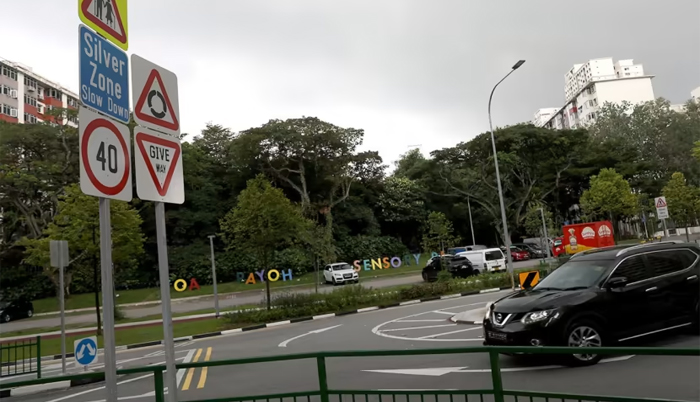![]() Home > Singapore
Home > Singapore
'Friendly Streets' Pilot Part Of People-Centric Vision To Make Motorists More Gracious, But Enforcement Still Key: Analysts, Residents

A view of a roundabout at a Silver Zone in Toa Payoh taken on Feb 5, 2023.Nuria Ling/TODAY
![]() March 4th, 2023 | 07:25 AM |
March 4th, 2023 | 07:25 AM | ![]() 427 views
427 views
SINGAPORE
The Ministry of Transport said that it will pilot a new “Friendly Streets” initiative that will make pedestrian-heavy streets within housing estates even livelier and safer
The initiative builds on existing efforts by the Land Transport Authority, including Silver Zones and School Zones
Silver Zones have largely been a success, with the accident rate for senior pedestrians across all zones down by 80 per cent since 2014
Residents in Silver Zone neighbourhoods said that built infrastructure must go hand-in-hand with shifts in social attitudes for such initiatives to succeed
These changes will slowly move Singapore away from a traditional paradigm prioritising vehicle movement to a future people-centric model, analysts said
The "Friendly Streets" pilot, coupled with past initiatives such as the Silver Zones and other people-friendly commutes, is part of the country's move towards a future where “cities are built for people, not cars and vehicles”, an analyst said on Friday (March 3).
However, such initiatives are no panacea for road accidents and more education is still needed to tell motorists that they should slow down and be more careful in such zones, another expert warned.
These Silver Zones, of which there are 27 today, have largely been a success, with data showing that the accident rate for senior pedestrians across all Silver Zones has gone down by 80 per cent since the start of the scheme in 2014.
A Silver Zone is a designated stretch with features intended to slow down traffic and make it safer for people to cross the road.
They are situated in neighbourhoods with a high population of older residents, and where there have been past accidents involving seniors.
The new Friendly Streets initiative, which features widened footpaths and road markings to slow vehicular traffic, builds on this success and will make pedestrian-heavy streets within housing estates even livelier and safer, analysts said.
Associate Professor Walter Theseira from the Singapore University of Social Sciences (SUSS), whose research interests include urban transportation, said: “These efforts continue a trend that has been in progress for some time towards reclaiming and redesigning low-speed streets in the middle of housing estates and pedestrian-heavy areas to make them more friendly for non-motorised road and path users."
These changes will gradually move Singapore away from a traditional paradigm prioritising vehicle movement to a future model where “cities are built for people, not cars and vehicles”, he added.
Agreeing, transport engineering consultant Gopinath Menon said: “Although our roads have catered to all road users, they have tended to be vehicle-centric.”
This emphasis is now shifting in line with a long-term car-lite vision, which will see the reclamation of some road space from vehicles for the benefit of all other road users.
Dr Cecilia Rojas, a lecturer in the Logistics and Supply Chain Management Programme at SUSS, said that in the long run, these changes will result in a vibrant society where more active trips and interactions between different user groups are encouraged.
EDUCATION, SOCIAL ATTITUDES MUST COMPLEMENT BUILT INFRASTRUCTURE
While purposefully built infrastructure is a great first step, Dr Rojas highlighted that education is still necessary.
“We all have to be made aware that just because the facilities are there, it is not immediately safe. We have to play a role by conducting ourselves with care and taking others into consideration, especially at Silver and School Zones where there are more vulnerable users,” she added.
At the Silver Zones that TODAY visited, residents said that even though road safety has generally improved in their neighbourhoods, they still remain cautious when out and about.
This means never assuming that motorists will always adhere to the rules.
Mrs Chew, 83, a resident in Marine Crescent, observed that some drivers do not stop at crossings.
Another older resident in nearby Marine Terrace who declined to be named said: “If people don’t comply or don’t care, what can we do? It’s beneficial only if people comply.”
Beyond infrastructural changes, the new Friendly Streets aim to encourage gracious road behaviour among all users in the long run.
Dr Raymond Ong, associate head of research in the department of civil and environmental engineering at the National University of Singapore, said: “As a planner or designer, there are ways in which we can engineer behaviour and nudge commuters."
Assoc Prof Theseira said that the changes are meant to “alter motorist behaviour through design rather than just through rules (that have to be continually enforced)”.
“For example, it is well-established that motorist speed is related to their perception of how wide and straight roads are. Most motorists slow down on narrow and winding roads.”
However, he noted that there are reckless motorists who ignore this.
“In the end, you cannot prevent a motorist who is deliberately reckless from being so. Only enforcement and taking him or her off the road can help,” Assoc Prof Theseira added.
“This is all about adjusting the behaviour for the majority who are not intentionally reckless but who may drive too fast because the conditions of the road design supports it by being too straight and wide in a residential area.”
Ultimately, however, LTA said that “the success of such projects will depend on the strengths of the local 'kampung spirit' in looking out for one another when using our streets and commuter facilities”.
Source:
courtesy of TODAY
by DEBORAH LAU
If you have any stories or news that you would like to share with the global online community, please feel free to share it with us by contacting us directly at [email protected]